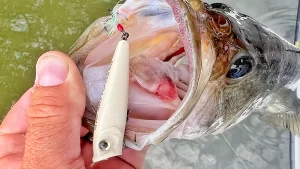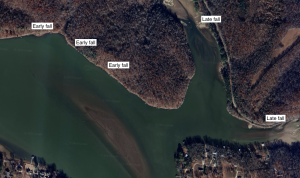As summer loosens its grip and the days begin to shorten, fall marks a significant transition in bass fishing. Cooler nights and days bring a much-anticipated change for anglers, as bass start to move from deep waters back into the shallows. However, these fish won’t be found everywhere immediately. Anglers must strategically search for the first shallow bass of fall, and the following tips will help pinpoint their locations effectively.
Start Near Deep Water
When looking for the first shallow bass of the season, proximity to deep water is crucial. While bass often cover long distances, the chances of finding them increase dramatically the closer the search stays to deeper waters. Heading straight to the back of a large bay off the main lake might seem like a good idea, but early in the fall, such areas may not hold many fish.
Instead, focus on spots where the main river channel transitions into flats near bluff walls. These transitional zones collect bass, which can easily move from 20 feet of water to shallower spots in a matter of seconds. Areas like this offer bass quick access to cover, allowing them to transition more easily between depths.

Watch for Bait and Activity
During this time of year, scanning the water surface for signs of life is essential. Bass tend to follow baitfish, so seeing surface activity can lead to bass-rich areas. Signs like “nervous water,” where baitfish frantically swim near the surface to avoid predators, can indicate the presence of feeding bass below.
In other instances, bass themselves may be visible, actively busting through bait schools. These visual cues can help focus efforts on specific spots, increasing the likelihood of landing a catch. If an area lacks visible bait or fish activity, it’s wise to move on. But if signs of life are present, anglers should stay, adapt their techniques, and work on getting those bites.
Leverage Current
Current plays a critical role in locating shallow bass in late summer and early fall. Moving water is typically cooler and more oxygenated than stagnant water, making it more attractive to bass. Many lakes, streams, and rivers can become stagnant during this period due to scarce rainfall and occasional drought conditions.
Power companies often generate electricity by releasing water from dams, creating some of the most productive fishing spots during early fall. These discharge areas can be hotspots for bass that prefer cooler, oxygen-rich water. Additionally, anglers should look for creeks or large pockets where late summer storms have caused runoff. Such areas tend to concentrate fish, offering another excellent opportunity for a successful outing.

Seek Cover and Shade
Although fall brings cooler weather, water temperatures in many areas south of the Mason-Dixon line can remain in the 80s when summer transitions to fall. For cold-blooded bass, these temperatures are still quite warm. Since a bass’s mood and behavior are dictated by its environment, finding cooler, shaded areas can make all the difference.
Cover and shade become vital in early fall as bass return to shallower waters in search of food. These fish often hunker down in brush piles, patches of grass, or under docks to cool off and acclimate to the warmer waters closer to shore. These spots not only offer relief to the fish but also make them easier for anglers to target, providing ideal locations to focus fishing efforts.
Pay Attention to Water Color
Water clarity is another factor to consider when searching for fall bass. Often, a green or brown tint in the water indicates an algae bloom, which can deplete oxygen levels as the algae die off. Fish in these areas tend to become sluggish, making them harder to catch.
Clear or even slightly muddy water, on the other hand, often contains better oxygen levels, particularly if there’s a current. While algae blooms can drive fish away, there are exceptions. Sometimes baitfish and bass are already present in an area experiencing an algae bloom. If that’s the case, there’s no need to immediately abandon the spot, but it’s worth revisiting after a few days to check if both the bait and bass have moved on.
Fall offers some of the best shallow-water fishing of the year, but it requires knowing where to look. By following these tips and adjusting tactics based on water conditions, activity, and location, anglers can increase their chances of finding success on the water. With cooler weather approaching, now is the perfect time to apply these strategies and land the first shallow bass of the season.
Images/Source: Wired2Fish





